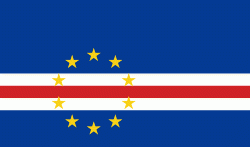Mindelo
Mindelo is a port city in the northern part of the island of São Vicente in Cape Verde. Mindelo is also the seat of the parish of Nossa Senhora da Luz, and the municipality of São Vicente. The city is home to 93% of the entire island's population. Mindelo is known for its colourful and animated carnival celebrations, with roots in Portuguese traditions later influenced by the Brazilian culture.
A settlement at Mindelo was founded in 1793 by the Portuguese. It was initially named Nossa Senhora da Luz, renamed Leopoldina around 1820 after the Queen consort. In 1838 it was renamed Mindelo after the 1832 Landing at Mindelo, north of Porto. It became a coal deposit for ships of the British East India Company in 1838, followed by the Royal Mail Steam Packet Company in 1850. The settlement became a town (vila) in 1858, and had 1,400 inhabitants then. It became a city (cidade) in 1879, and had 3,717 inhabitants then. In 1884 a submarine communications cable was laid between Europe, Africa, India and North America, making Mindelo an important communications centre for the British Empire.
From the beginning of the 20th century the port of Mindelo lost its importance for transatlantic navigation. Causes for this were the shift from coal to oil as fuel for ships, the rise of competing ports like Dakar and the Canary Islands and the lack of investment in port infrastructure. Between 1910 and 1940 there were several strikes in Mindelo, and on 7 June 1934 there were riots in the streets of Mindelo, caused by unemployment and poverty. One man was killed; several were injured.
Between 1940 and 1958 three prolonged periods of severe drought, combined with soil erosion and overgrazing, brought famine in Cape Verde. In the whole archipelago, about 45,000 people died and 20,000 people emigrated. Mindelo attracted immigrants, notably from nearby Santo Antão, and continued to grow.
Mindelo was the cultural capital of the Portuguese-speaking world from November 2002 until November 2003. Mindelo is also considered the cultural capital of Cape Verde.
A settlement at Mindelo was founded in 1793 by the Portuguese. It was initially named Nossa Senhora da Luz, renamed Leopoldina around 1820 after the Queen consort. In 1838 it was renamed Mindelo after the 1832 Landing at Mindelo, north of Porto. It became a coal deposit for ships of the British East India Company in 1838, followed by the Royal Mail Steam Packet Company in 1850. The settlement became a town (vila) in 1858, and had 1,400 inhabitants then. It became a city (cidade) in 1879, and had 3,717 inhabitants then. In 1884 a submarine communications cable was laid between Europe, Africa, India and North America, making Mindelo an important communications centre for the British Empire.
From the beginning of the 20th century the port of Mindelo lost its importance for transatlantic navigation. Causes for this were the shift from coal to oil as fuel for ships, the rise of competing ports like Dakar and the Canary Islands and the lack of investment in port infrastructure. Between 1910 and 1940 there were several strikes in Mindelo, and on 7 June 1934 there were riots in the streets of Mindelo, caused by unemployment and poverty. One man was killed; several were injured.
Between 1940 and 1958 three prolonged periods of severe drought, combined with soil erosion and overgrazing, brought famine in Cape Verde. In the whole archipelago, about 45,000 people died and 20,000 people emigrated. Mindelo attracted immigrants, notably from nearby Santo Antão, and continued to grow.
Mindelo was the cultural capital of the Portuguese-speaking world from November 2002 until November 2003. Mindelo is also considered the cultural capital of Cape Verde.
Map - Mindelo
Map
Country - Cape_Verde
 |
 |
The Cape Verde archipelago was uninhabited until the 15th century, when Portuguese explorers discovered and colonized the islands, thus establishing the first European settlement in the tropics. Because the Cape Verde islands were located in a convenient location to play a role in the Atlantic slave trade, Cape Verde became economically prosperous during the 16th and 17th centuries, attracting merchants, privateers, and pirates. It declined economically in the 19th century after the suppression of the Atlantic slave trade, and many of its inhabitants emigrated during that period. However, Cape Verde gradually recovered economically by becoming an important commercial center and useful stopover point along major shipping routes. In 1951, Cape Verde was incorporated as an overseas department of Portugal, but its inhabitants continued to campaign for independence, which they achieved in 1975.
Currency / Language
| ISO | Currency | Symbol | Significant figures |
|---|---|---|---|
| CVE | Cape Verde escudo | Esc or $ | 2 |
| ISO | Language |
|---|---|
| PT | Portuguese language |















